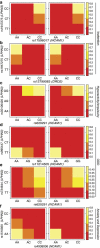A two-locus genetic interaction between LPHN3 and 11q predicts ADHD severity and long-term outcome
- PMID: 22832519
- PMCID: PMC3309519
- DOI: 10.1038/tp.2011.14
A two-locus genetic interaction between LPHN3 and 11q predicts ADHD severity and long-term outcome
Abstract
The severity of attention-deficit/hyperactivity disorder (ADHD) symptoms is a major predictor of long-term ADHD outcome. To investigate if two-locus interactions might predict ADHD severity, we studied a sample of 1341 individuals from families clustering ADHD, using the Vanderbilt Assessment Scale for Parents. Latent class cluster analysis was used to construct symptom profiles and classify ADHD severity. Single nucleotide polymorphisms (SNPs) spanning ADHD-linked chromosomal regions on chromosomes 4, 5, 10, 11, 12 and 17 were genotyped. SNPs associated with ADHD severity were identified and potential two-locus genetic interactions were tested. We found that SNPs within the LPHN3 gene interact with SNPs spanning the 11q region that contains DRD2 and NCAM1 not only to increase the risk of developing ADHD but also to increase ADHD severity. All these genes are identified to have a major role in shaping both brain development and function. These findings demonstrate that genetic interactions may predict the severity of ADHD, which in turn may predict long-term ADHD outcome.
Figures


References
-
- Visser S, Bitsko R, Danielson M, Perou R. Increasing prevalence of parent-reported attention-deficit/hyperactivity disorder among children --- United States, 2003 and 2007. Mortal Morb Wkly Rep. 2010;59:1439–1443. - PubMed
-
- American Psychiatric Association Diagnostic and Statistical Manual of Mental Disorders4th edn, text revision ed.American psychiatric Association: Washington, DC; 2000
-
- Barry T, Lyman R, Klinger L. Academic underachievement and attention-deficit/hyperactivity disorder: the negative impact of symptom severity on school performance. J Sch Psychol. 2002;40:259–283.
-
- Riley AW, Spiel G, Coghill D, Dopfner M, Falissard B, Lorenzo MJ, et al. Factors related to health-related quality of life (HRQoL) among children with ADHD in Europe at entry into treatment. Eur Child Adolesc Psychiatry. 2006;15 (Suppl 1:I38–I45. - PubMed
Publication types
MeSH terms
Substances
Grants and funding
LinkOut - more resources
Full Text Sources
Medical
Research Materials
Miscellaneous

